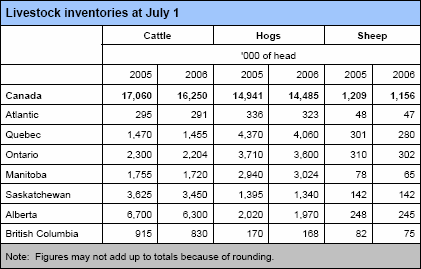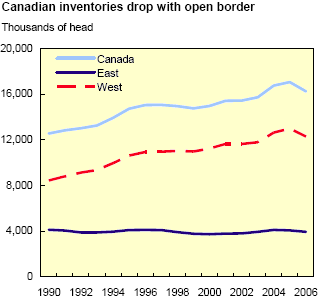



Canadian Cattle Statistics August 2006
By Statistics Canada - Canada’s national cattle herd has plunged by 810,000 head – a near record decline for a single year – following the reopening of the American border to live animals, according to the annual Livestock Survey of 10,000 producers. Most of these animals were exported to the United States.As of July 1, cattlemen reported 16.2 million head on their farms, down 4.7% from the record 17.1 million head on the same date last year. It was the first decline in the national herd in seven years.
Even so, it was still 814,000 above the level at July 1, 2002, prior to the border closure.
The American border was reopened to live cattle under 30 months of age on July 18, 2005. The ban on Canadian cattle and beef took effect after disclosure of a case of bovine spongiform encephalopathy (BSE) on May 20, 2003.
In general, inventories in the West rose during the early 1990s as farmers increased production in response to expanding export markets. With the door to the U.S. markets slammed shut, thousands of cattle were held back on Canadian farms, costing cattlemen dearly to feed them.
The livestock survey also showed declines in both hog and sheep inventories during the year. Farmers reported 1,156,000 sheep on their farms, down 4.4%.


Exports of live cattle resume
Exports of live cattle to the United States rose rapidly once the border was reopened in July 2005. However, recently, monthly exports have tumbled as drought-stricken U.S. ranchers shipped cattle early, pushing U.S. slaughter up and prices down. Reduced U.S. demand for Canadian cattle coupled to lower prices in this country, partially due to a strong Canadian dollar, discouraged Canadian exports.
In the year up to July 1, 2006, total cattle exports amounted to 1,140,000 head, only 22% below the pre-BSE level. There were no exports during the two previous 12-month periods. In the year up to July 1, 2003, Canadian cattlemen exported 1,458,000 animals.
Once the border was reopened to cattle, beef meat exports declined, partially offsetting the higher cattle exports.
Part of the decline can be attributed to a three-week strike at Lakeside Packers in Alberta in late October and early November of 2005. Even so, the lower monthly exports have been sustained.

Cattle herd declines in all regions
Cattle numbers fell in all provinces, but the decline was more dramatic on the Prairies. The herd in Manitoba, Saskatchewan and Alberta, combined, plunged by 610,000 head, which accounted for three-quarters of the total decline up to July 1 this year.
Alberta’s herd, the largest of any province, plunged 6.0%, Saskatchewan’s fell 4.8%, and Manitoba’s, 2.0%. In British Columbia, the herd dropped by 9.3%. In central Canada, Quebec’s cattle count edged down 1.0%, while Ontario’s was 4.2% lower.
The Prairie Provinces accounted for the vast majority of the increase in cattle numbers during the three-year period leading up to the July 1, 2005 record.
Combined, the herd in those three provinces rose by 1.3 million head during this time, accounting for 79% of the total 1.6 million nationwide gain.
Slaughter levels have also been a key factor in the cattle business. During 2004 and the first half of 2005, levels hit record highs. They were fuelled by increased slaughter capacity, domestic demand, strong international demand for Canadian beef and lower levels of beef imports.
However, levels have tapered off in the wake of lower exports of beef meat, now that the border is open to live cattle. Slaughter in the year up to July 1, 2006, was down 8.0% from the previous 12 months. Cattle prices improved during the fall of 2005. Prices as of December 2005 amounted to 94% of prices experienced during December 2002, before the ban was imposed. However, prices have since slipped, partially coinciding with a stronger Canadian dollar.
Further Information
To continue reading this article please click here (PDF)


